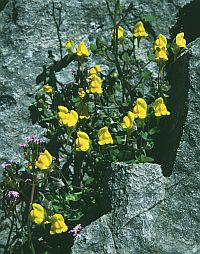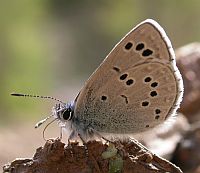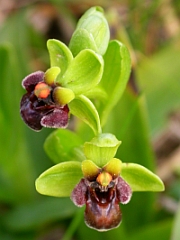 |
Natural history excursions around the village of Grazalema
 Puerto de Las Palomas
© Teresa Farino
Puerto de Las Palomas
© Teresa Farino
A good place to start looking for wildlife in the spring is the picturesque white village of Grazalema
itself (830m), nestling at the foot of the Sierra del Endrinal. The road leading west out of the town
towards El Bosque and Zahara is shaded by tall limestone cliffs which harbour an interesting collection
of plants which thrive in humid conditions, notably the lovely white bells of Ornithogalum reverchonii,
the succulent Afro-Iberian endemic Sedum mucizonia, the large, cream-flowered catchfly Silene andryalifolia,
unique to southern Spain, and the saxifrage Saxifraga bourgeana and white-flowered Omphalodes commutata,
both of which are found only here and in the Serranía de Ronda to the east. A small path winds up to a
ruined chapel and a statue of Christ which overlooks the town, through pinewoods interspersed with rocky
pastures teeming with Spanish bluebell and man, pyramidal and lizard orchids in early summer, while typical
birds include short-toed treecreeper, black redstart, Bonelli's warbler, firecrest, long-tailed tit and
serin.
The mirador in Grazalema's main car-park provides splendid views to the east, while closer at hand the
cliffs are adorned with splendid frothy clusters of the Afro-Iberian endemic crucifer Biscutella frutescens;
 Linaria platycalyx
© Teresa Farino
one of Grazalema's most charismatic plants. In early May the air is filled with wheeling crag and house
martins, swallows, swifts and pallid swifts, while the distinctive song of a myriad nightingales drifts up
from the vegetation along the small stream below. The narrow cobbled trail that you can see zigzagging down
the cliffs is accessed from behind the church to the left of you, the limestone rockgardens along the way
being populated by the pink, spurred flowers of the annual valerian Centranthus macrosiphon
(another Afro-Iberian endemic), cymbalaria-leaved speedwell, the dandelion-like Hyoseris radiata,
intermediate periwinkle, the red-flowered Cynoglossum cheirifolium and Linaria platycalyx, whose yellow
flowers and glaucous leaves in whorls of three are found only here and in the neighbouring Serranía de Ronda.
Linaria platycalyx
© Teresa Farino
one of Grazalema's most charismatic plants. In early May the air is filled with wheeling crag and house
martins, swallows, swifts and pallid swifts, while the distinctive song of a myriad nightingales drifts up
from the vegetation along the small stream below. The narrow cobbled trail that you can see zigzagging down
the cliffs is accessed from behind the church to the left of you, the limestone rockgardens along the way
being populated by the pink, spurred flowers of the annual valerian Centranthus macrosiphon
(another Afro-Iberian endemic), cymbalaria-leaved speedwell, the dandelion-like Hyoseris radiata,
intermediate periwinkle, the red-flowered Cynoglossum cheirifolium and Linaria platycalyx, whose yellow
flowers and glaucous leaves in whorls of three are found only here and in the neighbouring Serranía de Ronda.
Once at the foot of the cliff, look out for jagged, silver-leaved clumps of the yellow-flowered Centaurea
clementei (unique to south-west Spain) and the pink-flowered, round-leaved woundwort Stachys circinata on the
 Black-eyed Blue
Black-eyed Blue
Glaucopsyche melanops
© Teresa Farino
sheer limestone above you, while the rubbly pastures here often support robust leafy spikes of the dusky-blue-flowered
stavesacre, also known as licebane, as well as fat cylinders of one of the most beautiful of all viper's-buglosses:
Echium albicans, with silvery leaves and blue-and-pink flowers, also confined to southern Spain. Choughs and
griffon vultures are usually present overhead, while the base of the cliff often houses a black wheatear
nest and blue rock thrushes forage amid the limestone outcrops.
If you then head west and south, taking the A-374 towards Ubrique, you'll soon come to an unfenced area
of damp pastures on the left (about a kilometre past the left turn (A-372) to Ronda). Known as La Rana, this
is one of the best areas for orchids and other monocots that I know of in the park, with late April-early May
species including tongue orchid, small-flowered serapias, bumble-bee, sawfly, yellow and woodcock ophrys, and
Lange's and green-winged orchids, with dense-flowered orchids in the pine copses to the east. The pastures are
 Bumble-bee Ophrys
Bumble-bee Ophrys
Ophrys bombyliflora
© Teresa Farino
also studded with paper-white daffodils from January onwards, with May bringing a colourful assemblage of Spanish
iris, the low-growing star-of-Bethlehem Ornithogalum orthophyllum, tassel hyacinth, white asphodel, rosy garlic,
the Spanish endemic Anthericum baeticum and the magnificent Portuguese squill. Here too you can find elder-leaved
figwort, with large vermilion flowers, and the robust crucifer Crambe filiformis, with sprays of tiny white flowers,
both of which are Afro-Iberian endemics.
La Rana also turns up a wealth of butterflies in early summer, including Adonis, black-eyed and false
baton blues, red-underwing skipper, Moroccan orange-tip and the eye-catching Spanish festoon. Look out too
for woodchat shrike, bee-eater and hoopoe in the surrounding western holm oaks and low scrub, while the
telegraph wires which stretch across the site are often utilised by woodlark and rock sparrow. The southerly
continuation of this road, however, between the village of Villaluenga del Rosario and Benaocaz, is much more
rewarding for birds, the scrubby pastures and limestone outcrops hosting a diverse community of Thekla lark,
black-eared wheatear, blue rock thrush, rock thrush, melodious warbler, southern grey shrike and rock bunting.
This long, narrow valley, backed by cliffs on either side, is also a good place to watch for some of the larger raptors
of Grazalema, notably golden and Bonelli's eagles, as well as for alpine swift and peregrine.
|